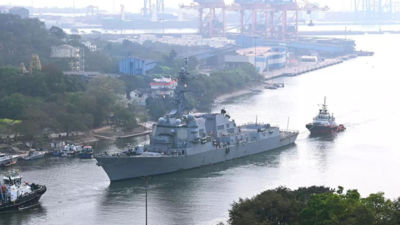Description

Disclaimer: Copyright infringement not intended.
Context
- Indian security forces are acquiring unmanned, weaponized marine boats and undersea swarm drones for surveillance along the Indian coast and Pangong Lake.
- The Indian Navy has approved the acquisition of 12 autonomous weaponized boat swarms developed by Pune-based Sagar Defence Engineering.
Details
- These boats offer significant tactical advantages in underwater and surface warfare, equipped with advanced cameras, radar tracking systems, 12.7 mm SRCG guns, and unmanned aerial vehicles.
Key Features of the Boats
- Multi-mission capabilities.
- Two advanced cameras for surveillance.
- Day and night radar tracking system.
- Armed with a 12.7 mm SRCG gun.
- Remote-controlled.
- Equipped with an unmanned aerial vehicle (UAV).
- 48 hours of operation with one tank.
- 360-degree situational awareness.
- Navigation system includes Isro’s navigation system NaVIC.
- Indian Navy to keep 10 boats for operations, two to be used by the Indian Army for Pangong Lake operations.
.jpg)
Importance for Pangong Lake
- Pangong Tso is intensely monitored by both Indian and PLA troops along the LAC.
- To counter Chinese threats, Indian Army had previously ordered fast patrol boats and troop-carrying fibreglass boats.
- The new unmanned boats will enhance surveillance capabilities and match the PLA's heavier Type 92B patrol boats.
Additional Technologies
- The Navy has ordered 30 underwater swarms of drones called autonomous underwater vehicles (AUVs) for mine detection and countermeasure operations.
- Seven other types of drones have been ordered for cargo lifting and medical evacuation purposes.
Boat Specifications
- Named "Mata Matangi."
- Capable of operating at night.
- Payload capacity of 2000kg-plus.
- Speed of 50 knots-plus.
- Self-righting capability.
- Can withstand waves of six meters long.
Pangong Tso - The High Altitude Saltwater Lake in Ladakh
- Pangong Tso, also referred to as Pangong Lake, is a mesmerizing high-altitude saltwater lake nestled amidst the trans-Himalayan region of Ladakh in Northern India.
- This stunning lake, surrounded by barren mountains, has become a popular tourist attraction due to its exceptional beauty and unique geographical features.
Altitude and Location:
- Pangong Tso is situated at a staggering altitude of approximately 4,350 meters (14,270 feet) above sea level.
- It extends from India to Tibet (China), with approximately two-thirds of the lake lying within Chinese territory and the remaining third in India.
Geological Origins:
- The lake is believed to have formed as a result of tectonic activity in the region.
- It is classified as an endorheic lake, meaning it has no outlet, and any water it receives is from precipitation, glacial meltwater, or streams, with no outflow.
Unique Saltwater Lake:
- Pangong Tso is unique due to its saline water, which remains undrinkable.
- The salinity is relatively low compared to seawater but prevents most vegetation from growing in the lake or its vicinity.
Length and Depth:
- The lake is about 134 kilometers (83 miles) long, making it one of the longest lakes in the region.
- While the lake is impressively long, its width varies, with the widest part stretching over 5 kilometers.
- The average depth of the lake is around 40 meters (130 feet).
Changing Colors:
- One of the most enchanting features of Pangong Tso is its ever-changing colors.
- The lake can appear in shades of blue, green, or even turquoise, depending on the angle of the sun and weather conditions.
Border Dispute:
- Pangong Tso has been a subject of border disputes between India and China for decades.
- The Line of Actual Control (LAC), which separates the two countries, passes through the lake, leading to occasional tensions and stand-offs.
Flora and Fauna:
- Due to the high salinity of the lake, it supports minimal aquatic life.
- However, the surrounding areas are home to several species of migratory birds, including gulls and Brahminy ducks.

Conclusion
- The acquisition of these unmanned weaponized boats and drones is a significant milestone in India's efforts to enhance its air defense and surveillance capabilities.
- These technologies will bolster India's security infrastructure and reduce reliance on foreign imports.
|
PRACTICE QUESTION
Q. What geological phenomenon is believed to have contributed to the formation of Pangong Tso?
a) Earthquake
b) Volcanic eruption
c) Tectonic activity
d) Meteor impact
Answer: c)
|














